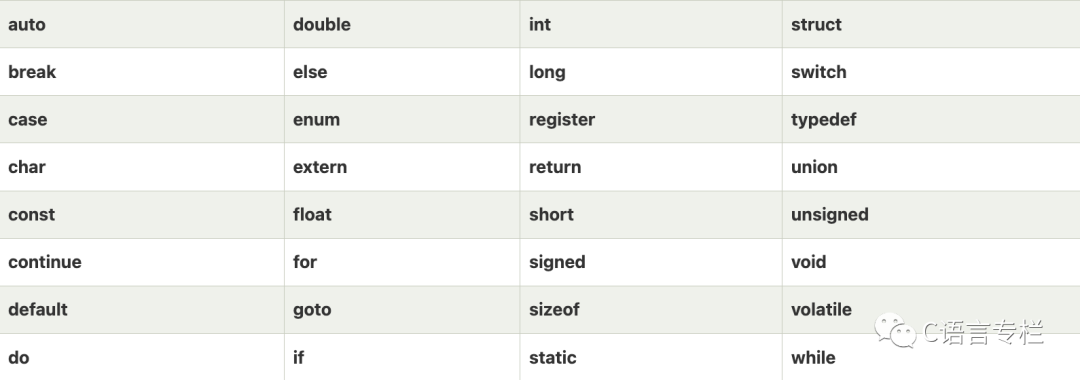Tokens in C language are the most important elements used to create programs. We can define tokens as the smallest individual units in C language. Just as we cannot construct a sentence without words, similarly, in C language, we cannot create a program without tokens. Therefore, we can say that tokens in C language are the basic components for creating C language programs.
Tokens in C language can be classified into the following categories:
Next, let’s understand each token one by one.
👇 Click to receive👇
👉 Collection of C Language Knowledge Materials
Keywords in C can be defined as predefined or reserved words that have their own significance, with each keyword having its own function. Since keywords are predefined words by the compiler, they cannot be used as variable names. If a keyword is used as a variable name, it means we have assigned an unauthorized different meaning to the keyword. C language supports the following 32 keywords:

In C, identifiers are used to name variables, functions, arrays, structures, etc. Identifiers in C are user-defined words. They can consist of uppercase letters, lowercase letters, underscores, or digits, but the first character must be an underscore or a letter. Identifiers cannot be used as keywords. The rules for constructing identifiers in C are as follows:
The first character of an identifier must be a letter or an underscore, followed by any characters, digits, or underscores. Identifiers cannot start with a digit. In identifiers, uppercase and lowercase letters are distinct. Therefore, we can say that identifiers are case-sensitive. Identifiers cannot contain commas or spaces. Keywords cannot be used as identifiers. The length of identifiers should not exceed 31 characters. Identifiers should be written in a meaningful, concise, and easy-to-read manner.
Strings in C are always represented as character arrays, ending with a null character ‘\0’. This null character indicates the end of the string. Strings in C are enclosed in double quotes, while characters are enclosed in single quotes. The size of a string is the number of characters it contains.
Now, let’s describe strings in different ways:
char a[10] = “javatiku”; // The compiler allocates 10 bytes of memory for the ‘a’ array.
char a[] = “javatiku”; // The compiler allocates memory at runtime.
char a[10] = {‘j’,’a’,’v’,’a’,’t’,’i’,’k’,’u’,’\0′}; // The string is represented in character form.
Operators in C are special symbols used to perform specific functions. Operators are applied to operands, which are the objects on which the operators operate.
Constants are values assigned to variables that remain unchanged throughout the program, meaning the constant value cannot change.
There are two ways to declare constants:
-
-
Using the #define preprocessor for constant types in C

C uses several special characters that have specific meanings and cannot be used for other purposes.
-
Square brackets [ ]: Opening and closing brackets indicate single and multi-dimensional subscripts.
-
Parentheses ( ): Used for function declarations and function calls. For example, printf() is a predefined function.
-
Curly braces { }: Used to open and close code blocks, such as loops.
-
Comma (,): Used to separate multiple statements, for example, separating function parameters in function calls, or separating multiple variable values in a single printf statement.
-
Hash/preprocessor (#): Used for preprocessor directives. It indicates that we are using header files.
-
Asterisk (*): This symbol is used to denote pointers and also serves as a multiplication operator.
-
Tilde (~): Used as a destructor to release memory.
-
Dot (.): Used to access members of structures or unions.
Programmer Technical Group
Scan the QR code to join the group and remember to note: city, nickname, and technical direction.

